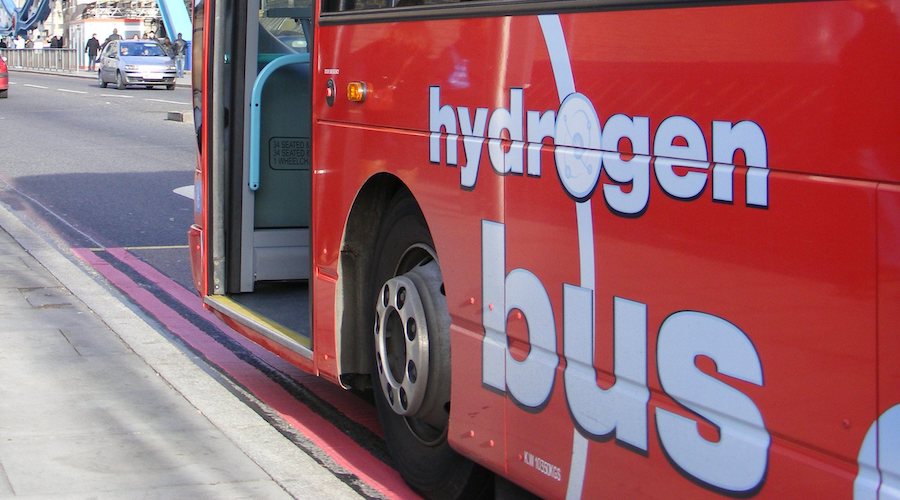Global S&T Development Trend Analysis Platform of Resources and Environment
| Nickel anode key to making fuel cells cheaper, more efficient | |
| admin | |
| 2022-03-31 | |
| 发布年 | 2022 |
| 语种 | 英语 |
| 国家 | 国际 |
| 领域 | 地球科学 |
| 正文(英文) |  Hydrogen fuel cell bus. (Reference image by Sludge G, Flickr).
Researchers at Cornell University found that a nitrogen-doped, carbon-coated nickel anode can catalyze an essential reaction in hydrogen fuel cells at a fraction of the cost of the precious metals currently used. In their view, the discovery could accelerate the widespread use of clean hydrogen fuel cells in vehicles and other applications. In a paper published in the journal Proceedings of the National Academy of Sciences, the researchers explain that expensive precious metals, such as platinum, are currently required in hydrogen fuel cells to efficiently catalyze the reactions they employ to produce electricity. Although alkaline polymer electrolyte membrane fuel cells (APEMFCs) enable the use of non-precious metal electrocatalysts, they lack the necessary performance and durability to replace precious-metal-based systems. A fuel cell produces electricity through the hydrogen oxidation reaction (HOR) and an oxygen reduction reaction (OOR). Platinum, in particular, is a model catalyst for both reactions because it catalyzes them efficiently, and is durable in the acidic environment of a PEM fuel cell. According to the scientists, recent experiments with non-precious-metal HOR electrocatalysts aimed to overcome two major challenges: low intrinsic activity from too strong a hydrogen binding energy, and poor durability due to rapid passivation from metal oxide formation. In detail, the recent research looked to overcome these challenges by using a nickel-based electrocatalyst with a 2-nanometer shell made of nitrogen-doped carbon. The Cornell team’s hydrogen fuel cell has an anode (where hydrogen is oxidized) catalyst consisting of a solid nickel core surrounded by the carbon shell. When paired with a cobalt-manganese cathode (where oxygen is reduced), the resulting completely precious metal-free hydrogen fuel cell outputs more than 200 milliwatts per square centimetre. The group notes that the presence of nickel oxide species on the surface of the nickel electrode slows the hydrogen oxidation reaction dramatically. The nitrogen-doped carbon coating serves as a protection layer and enhances the HOR kinetics, making the reaction quicker and much more efficient. In addition, the presence of the graphene coating on the nickel electrode prevents the formation of nickel oxides—resulting in electrodes with dramatically enhanced lifetimes. These electrodes are also much more tolerant to carbon monoxide, which rapidly poisons platinum. “The use of this novel anode would dramatically lower prices enabling the application of alkaline fuel cells in a wide variety of areas,” lead researcher Héctor D. Abruña said in a media statement.
|
| URL | 查看原文 |
| 来源平台 | Minging.com |
| 文献类型 | 新闻 |
| 条目标识符 | http://119.78.100.173/C666/handle/2XK7JSWQ/348257 |
| 专题 | 地球科学 |
| 推荐引用方式 GB/T 7714 | admin. Nickel anode key to making fuel cells cheaper, more efficient. 2022. |
| 条目包含的文件 | 条目无相关文件。 | |||||
| 个性服务 |
| 推荐该条目 |
| 保存到收藏夹 |
| 查看访问统计 |
| 导出为Endnote文件 |
| 谷歌学术 |
| 谷歌学术中相似的文章 |
| [admin]的文章 |
| 百度学术 |
| 百度学术中相似的文章 |
| [admin]的文章 |
| 必应学术 |
| 必应学术中相似的文章 |
| [admin]的文章 |
| 相关权益政策 |
| 暂无数据 |
| 收藏/分享 |
除非特别说明,本系统中所有内容都受版权保护,并保留所有权利。
修改评论